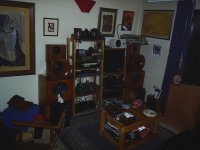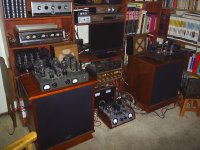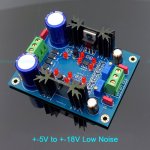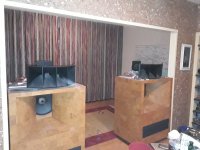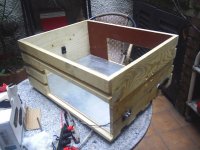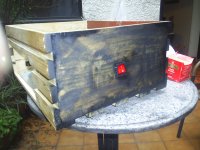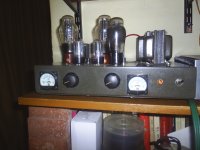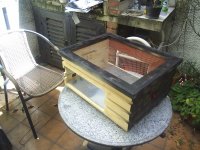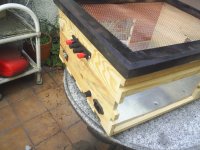For the last 15 years or so, I've only worked with solid state A class amplifiers and I've tested many types of power supply and regulation and so far I'm most satisfied with the CRC filter and Walt Jung regulators, they have the best ratio of investment and gain.
The regulators can provide 10A peak with a completely stable DC voltage at the output and an output impedance of ~5 milliohms at 1MHz. The price of just one LL2771 choke exceeds the price of all components for four regulators with the highest quality parts ($50 for op amps, $70-80 for other components), so the use of expensive and large chokes that can withstand currents greater than 2A makes no sense to me.
I agree that someone likes a different approach such as chokes, but I think it can hardly be compared with a quality regulator. Even with tubes I had better results with low noise HV regulators than with the classic approach.
The regulators can provide 10A peak with a completely stable DC voltage at the output and an output impedance of ~5 milliohms at 1MHz. The price of just one LL2771 choke exceeds the price of all components for four regulators with the highest quality parts ($50 for op amps, $70-80 for other components), so the use of expensive and large chokes that can withstand currents greater than 2A makes no sense to me.
I agree that someone likes a different approach such as chokes, but I think it can hardly be compared with a quality regulator. Even with tubes I had better results with low noise HV regulators than with the classic approach.
Hello,
I prefer the right kind of choke and in some cases an added shunt regulation. Shunt regulation for class A requires a lot of heatsink.
Allen Wright always wrote that the choke should be bigger than the power transformer.
The French wrote a lot about power supplies in the eighties of last century.
Most Hiraga and le monstre amps are difficult to build because parts are very hard to find. When i build my Hiraga Shinkoh resistors were available in Paris now most people use lower grade resistors. Same like Cosmos pot meters and copper foil capacitors.
The power caps available then in Paris ( Sic safco, cef, novea) much better than present times Kemet caps.
Back then double C core or EI core transformer now most people using toriodal transformers with no screen between primary and secondary side. BUT you can get 800 VA and not expensive to impress your friends.
Greetings,Eduard
I prefer the right kind of choke and in some cases an added shunt regulation. Shunt regulation for class A requires a lot of heatsink.
Allen Wright always wrote that the choke should be bigger than the power transformer.
The French wrote a lot about power supplies in the eighties of last century.
Most Hiraga and le monstre amps are difficult to build because parts are very hard to find. When i build my Hiraga Shinkoh resistors were available in Paris now most people use lower grade resistors. Same like Cosmos pot meters and copper foil capacitors.
The power caps available then in Paris ( Sic safco, cef, novea) much better than present times Kemet caps.
Back then double C core or EI core transformer now most people using toriodal transformers with no screen between primary and secondary side. BUT you can get 800 VA and not expensive to impress your friends.
Greetings,Eduard
Looking for information about the Walt Jung power regulated power supply circuit, I found this board. Is it a Chinese tale?
https://www.ebay.com/itm/255256255871
https://www.ebay.com/itm/255256255871
Attachments
and it is for that reason exaggerated prices of output transformers, tubes, etc. that I am dabbling in class A with solid state components. SaludosFor the last 15 years or so, I've only worked with solid state A class amplifiers and I've tested many types of power supply and regulation and so far I'm most satisfied with the CRC filter and Walt Jung regulators, they have the best ratio of investment and gain.
The regulators can provide 10A peak with a completely stable DC voltage at the output and an output impedance of ~5 milliohms at 1MHz. The price of just one LL2771 choke exceeds the price of all components for four regulators with the highest quality parts ($50 for op amps, $70-80 for other components), so the use of expensive and large chokes that can withstand currents greater than 2A makes no sense to me.
I agree that someone likes a different approach such as chokes, but I think it can hardly be compared with a quality regulator. Even with tubes I had better results with low noise HV regulators than with the classic approach.
Hello,
For my tube power amps i use solid state shunt regulators designed by Allen Wright. He recommends a choke input with the biggest choke you can find.
For my phono riaa preamp the famous Dutch designer Peter van Willenswaard uses a shunt regulator with tubes plus a choke input.
For my line preamp with tubes i asked him to make the same shunt supply with a lower output voltage and a choke input.
My DDDAC uses a choke input with shunt supples right at the spot where they need to be.
One of my audiophile friends in Vietnam uses a Nelson Pass single ended class A amp with a Lundahl LL2733 choke input.
Of course Lundahl is much easier to get here than in South America.
Greetings, eduard
For my tube power amps i use solid state shunt regulators designed by Allen Wright. He recommends a choke input with the biggest choke you can find.
For my phono riaa preamp the famous Dutch designer Peter van Willenswaard uses a shunt regulator with tubes plus a choke input.
For my line preamp with tubes i asked him to make the same shunt supply with a lower output voltage and a choke input.
My DDDAC uses a choke input with shunt supples right at the spot where they need to be.
One of my audiophile friends in Vietnam uses a Nelson Pass single ended class A amp with a Lundahl LL2733 choke input.
Of course Lundahl is much easier to get here than in South America.
Greetings, eduard
The price of just one LL2771 choke
If you like the sound with the Lundahl choke you may find it impossible to replicate this using a regulator. No matter how great those milliohms look on paper.
Not saying the one sound is necessarily better than the other. In many cases CRC sounds best to me, but resistor types should also not be ignored.
That regulator has nothing to do with Walt Jung's regulator, unfortunately there are copies everywhere today including in DIY audio.Looking for information about the Walt Jung power regulated power supply circuit, I found this board. Is it a Chinese tale?
https://www.ebay.com/itm/255256255871
Not yet, some parts of the circuit are protected by copyright but I hope everything will be published soon.Thanks Grunf, any schematic, diy pcb?
CRC is a wonderful thing, in my DAC all power supplies are designed that way. I use a Walt Jung shunt after the CRC filter as a regulator.If you like the sound with the Lundahl choke you may find it impossible to replicate this using a regulator. No matter how great those milliohms look on paper.
Not saying the one sound is necessarily better than the other. In many cases CRC sounds best to me, but resistor types should also not be ignored.
Something similar is in my Le monstre, only here I use series regulators.
I know that numbers in audio do not mean much, but even if the regulator I use has worse characteristics on paper, I would use it again because it gives the amplifier a new dimension of sound that is difficult to get with any classic power supply.
So far, I have tried these regulators on JLH69, Hiraga 20W A class and Le Monstre and I must say that I am very satisfied with the result, even with the first version of the regulator whose schematics can be found in this topic. Walt Jung himself participated in the later versions with his improvements.
Hello,
Just like most '' le monstre '' amps build in the last decades have nothing to do with the original one.
After the publication of the the original article there have been some modifications on the power supply.
The shop in Paris offered a few different ones with differences in the power supply.
The first publication about this amp dates from February 1983 and the latest one was two years later about using 45 AH car batteries that had like 3 hours listening and then two hours recharging if i remember correctly.
Now you can get more AH in a smaller enclosure or you could go for supercaps which can be charged quickly but cannot '' contain a lot of energy ''
Maybe google for "" ian Canada UCpure '' I think the maximum voltage is 15 volt for his design. BUT i am sure a smaller output amp with a bigger supply will sound better than the other way round.
Greetings, Eduard
p.s IF parts will still be available i would try that option for my 8 watt le monstre . I dont need that much power anyway
Just like most '' le monstre '' amps build in the last decades have nothing to do with the original one.
After the publication of the the original article there have been some modifications on the power supply.
The shop in Paris offered a few different ones with differences in the power supply.
The first publication about this amp dates from February 1983 and the latest one was two years later about using 45 AH car batteries that had like 3 hours listening and then two hours recharging if i remember correctly.
Now you can get more AH in a smaller enclosure or you could go for supercaps which can be charged quickly but cannot '' contain a lot of energy ''
Maybe google for "" ian Canada UCpure '' I think the maximum voltage is 15 volt for his design. BUT i am sure a smaller output amp with a bigger supply will sound better than the other way round.
Greetings, Eduard
p.s IF parts will still be available i would try that option for my 8 watt le monstre . I dont need that much power anyway
Attachments
I must say from experience that the CLC sounded better than a CRC or a C-reg-C. I used separate chokes in a version that I demo'd. It weighted some 20 kg - so later I reduced the build to smaller power supply versions, with every step in a smaller housing the highs got less brilliance and the lows less depth, but measurably it all was great. The point is that the regulation with CLC better filters the higher harmonics while they allow a great (i.e. short) recovery time.View attachment 1200797
Hello,
This was published in 1988 in french l'Audiophile magazine #43 written by Mr Johannet and Mr Walther
The choke was a 200mH model 0,7 ohm dcr. I used it in my 30 watt Hiraga and it was first used in Le Nemesis ( single ended transistor amp by Jean Hiraga.
Right drawing
#1 the shape of the '' dc '' at the first cap
#2 the shape at the second cap when using CRC
#3 The shape at the second cap when using CLC.
Pretty obvious. RC is only 6DB and LC is of course a 12 DB filter.
Greetings, eduard
I’m thinking about reducing the input sensitivity of my 8w le Monstre and have a couple of questions for the knowledgeable folk contributing to this thread.
- am I right in thinking that if the 1k2 and 47k resistors on the input are both changed to 10k this will reduce the sensitivity by half?
- if so, does this have knock on effects on the rest of the circuit, or is it a benign change? For example, would this change input impedance?
Grateful for any thoughts. I realise there are alternative solutions such as changing other components in the chain, but would like to focus on the Monstre at this stage.
- am I right in thinking that if the 1k2 and 47k resistors on the input are both changed to 10k this will reduce the sensitivity by half?
- if so, does this have knock on effects on the rest of the circuit, or is it a benign change? For example, would this change input impedance?
Grateful for any thoughts. I realise there are alternative solutions such as changing other components in the chain, but would like to focus on the Monstre at this stage.
Initial attenuation is 1.025 and after changing will became 2.
Initial input impedance is ~59KΩ and after changing will became ~20KΩ.
To not change to much the input impedance use 22KΩ or 33KΩ resistors, and with 27KΩ resistors will be close to initial input impedance.
Initial input impedance is ~59KΩ and after changing will became ~20KΩ.
To not change to much the input impedance use 22KΩ or 33KΩ resistors, and with 27KΩ resistors will be close to initial input impedance.
- Home
- Amplifiers
- Solid State
- Hiraga "Le Monstre"
